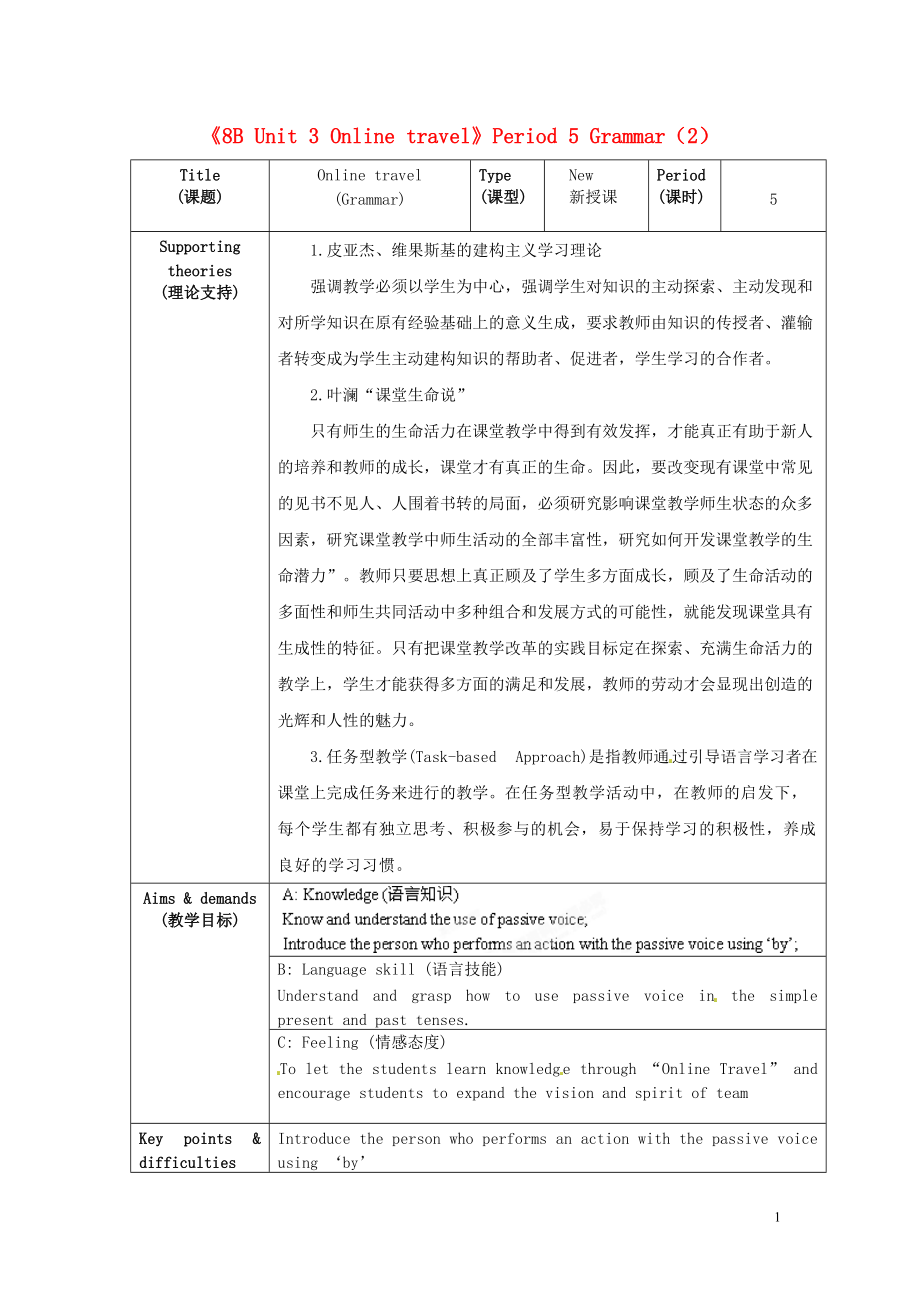《江蘇省海安縣大公初級中學(xué)八年級英語下冊《8B Unit 3 Online travel》Period 5 Grammar(2)教案 牛津版》由會員分享�,可在線閱讀,更多相關(guān)《江蘇省海安縣大公初級中學(xué)八年級英語下冊《8B Unit 3 Online travel》Period 5 Grammar(2)教案 牛津版(4頁珍藏版)》請?jiān)谘b配圖網(wǎng)上搜索����。
1、
《8B Unit 3 Online travel》Period 5 Grammar(2)
Title
(課題)
Online travel
(Grammar)
Type
(課型)
New
新授課
Period
(課時)
5
Supporting
theories
(理論支持)
1.皮亞杰��、維果斯基的建構(gòu)主義學(xué)習(xí)理論
強(qiáng)調(diào)教學(xué)必須以學(xué)生為中心���,強(qiáng)調(diào)學(xué)生對知識的主動探索�、主動發(fā)現(xiàn)和對所學(xué)知識在原有經(jīng)驗(yàn)基礎(chǔ)上的意義生成��,要求教師由知識的傳授者�����、灌輸者轉(zhuǎn)變成為學(xué)生主動建構(gòu)知識的幫助者����、促進(jìn)者,學(xué)生學(xué)習(xí)的合作者�。
2.葉瀾“課堂生命說”
只有師生的生命活
2、力在課堂教學(xué)中得到有效發(fā)揮�����,才能真正有助于新人的培養(yǎng)和教師的成長�,課堂才有真正的生命。因此�����,要改變現(xiàn)有課堂中常見的見書不見人、人圍著書轉(zhuǎn)的局面��,必須研究影響課堂教學(xué)師生狀態(tài)的眾多因素�����,研究課堂教學(xué)中師生活動的全部豐富性�����,研究如何開發(fā)課堂教學(xué)的生命潛力”����。教師只要思想上真正顧及了學(xué)生多方面成長,顧及了生命活動的多面性和師生共同活動中多種組合和發(fā)展方式的可能性�,就能發(fā)現(xiàn)課堂具有生成性的特征。只有把課堂教學(xué)改革的實(shí)踐目標(biāo)定在探索�����、充滿生命活力的教學(xué)上��,學(xué)生才能獲得多方面的滿足和發(fā)展�,教師的勞動才會顯現(xiàn)出創(chuàng)造的光輝和人性的魅力。
3.任務(wù)型教學(xué)(Task-based Approach)是指教師通過引
3��、導(dǎo)語言學(xué)習(xí)者在課堂上完成任務(wù)來進(jìn)行的教學(xué)���。在任務(wù)型教學(xué)活動中����,在教師的啟發(fā)下�����,每個學(xué)生都有獨(dú)立思考����、積極參與的機(jī)會,易于保持學(xué)習(xí)的積極性����,養(yǎng)成良好的學(xué)習(xí)習(xí)慣。
Aims & demands
(教學(xué)目標(biāo))
B: Language skill (語言技能)
Understand and grasp how to use passive voice in the simple present and past tenses.
C: Feeling (情感態(tài)度)
To let the students learn knowledge through “Online Travel” a
4���、nd encourage students to expand the vision and spirit of team
Key points & difficulties
(教學(xué)重���、難點(diǎn))
Introduce the person who performs an action with the passive voice using ‘by’
Use the passive voice and the correct tenses.
Teaching Methods
(教學(xué)方法)
Task-based approach
Situational Teaching M
5��、ethod
Aids:
課前準(zhǔn)備(教具����、活動準(zhǔn)備等)
Blackboard; computer
教 學(xué) 設(shè) 計
課前延伸(預(yù)習(xí))
1. Preview the new words of this part and try to master the usage of them.
2. Finish off the exercises of this part.
讓學(xué)生通過課前自學(xué)�����,不懂的問題可以互相討論解決預(yù)習(xí)中的一些問題���,為上課做準(zhǔn)備
Teaching Plan
(授課計劃)
Studying Plan
(學(xué)習(xí)計劃)
Aims
(設(shè)計意
6�����、圖)
課
內(nèi)
探
究
課
內(nèi)
探
究
學(xué)
StepⅠWarm up & Revision
1. Check the words in groups.
2. Preview work
(Check the answers.)
1.小組合作回顧單詞�。
2. 核對答案溫故知新��,自然引出已學(xué)的新句型�����。
Step II Presentation
Ask the student to say th
7����、e structure of the passive voice.
He / She / it was
Introduce the person who performs an action with the passive voice using ‘by’.
復(fù)習(xí)已學(xué)的被動語態(tài)的結(jié)構(gòu)在語境中相結(jié)合呈現(xiàn)新語言項(xiàng)目,再次回顧所學(xué)句型���,增強(qiáng)學(xué)生在學(xué)習(xí)被動語態(tài)時的信心����。
導(dǎo)
Step III Practice
Millie has bought a computer like Simon’s. However, she doesn’t know how to open he
8�、r e-dictionary on the computer. She called Simon and asks him for help. Now I am Simon, I tell her how to do it. Then you try to change them into passive voice with ‘by’.
1. You close the window.
2. You restart the computer.
3. You check the settings.
4. You connect the keyboard to the comput
9、er.
5. You double-click on the ‘a(chǎn)uto-run’ icon.
Simon has bought a new educational CD-ROM called ‘Saving Princess Laura’. Before he can play the game, he must pass a test.
(Show the pictures in Part B1 on pages 50-51 to the students.) Help Simon pass the test by rearranging the words to form c
10����、orrect sentences.
Millie has bought a new educational CD-ROM. Daniel is asking her some questions about it. (Show the profile of the game to the students.) According to the information about the CD-ROM, complete the conversation between Millie and Daniel in Part B2 on page 51.
1. 巧用語態(tài)的變換在對被動語
11、態(tài)進(jìn)行回顧的同時鞏固工作執(zhí)行者單詞by的運(yùn)用���。
2. 采用搶答形式進(jìn)行����,有利于培養(yǎng)學(xué)生的積極性�����,提高效率��。
3.講練結(jié)合,鞏固所學(xué)內(nèi)容�����。
練
Step IV
Production
Do some exercises.
對課后提升練習(xí)題進(jìn)行批改檢查
課后提升
Step Ⅴ Assignment
a. Go over what we have learnt.
b. Correct the mistakes in the following sentences.
1. Word processing skills is taught
12�、 in our school.
2. Football is played by all over the world.
3. The printer didn’t sold last month.
4. The book was bought by I yesterday.
5. The old people are spoken politely.
Keys: 1.is→are; 2.去掉by; 3.didn’t→wasn’t; 4.I→me; 5. are spoken→speak
c.完成《補(bǔ)充習(xí)題》Grammar部分的練習(xí)
控制作業(yè)量,作業(yè)針對課堂的內(nèi)容進(jìn)行再次回顧鞏固�����。全面復(fù)習(xí)并運(yùn)用所學(xué)的被動語態(tài)結(jié)構(gòu)解答問題,達(dá)成語法學(xué)習(xí)的目標(biāo)�。
4
 江蘇省海安縣大公初級中學(xué)八年級英語下冊《8B Unit 3 Online travel》Period 5 Grammar(2)教案 牛津版
江蘇省海安縣大公初級中學(xué)八年級英語下冊《8B Unit 3 Online travel》Period 5 Grammar(2)教案 牛津版

